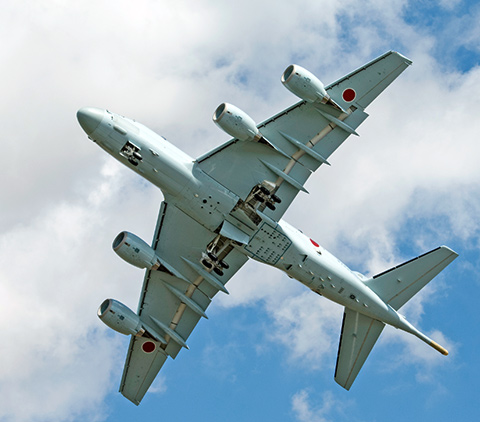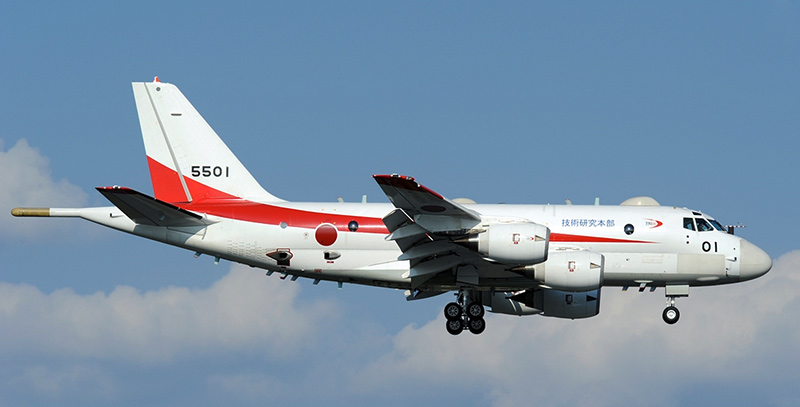
Never seen before outside of Japan and moreover on this western side of the planet, the Japanese Navy Kawasaki P-1 stole the show at the recent International Air Tattoo held at RAF Fairford in England. Two aircraft with their respective crew are on tour in Great-Britain having deployed from their home-base at Atsugi near Yokohama, Japan.
The Kawasaki P-1 is actually the only new anti-submarine long-range patrol aircraft developped out of the drawing board since the Breguet Atlantic some fifty years ago ! Contrary to the Lockheed P-3 Orion, derived from the commercial Lockheed Electra, the BAe Nimrod, a military variant of the de Haviland Comet, or even the Boeing P-8 Poseidon (which is a militarized version of the Boeing 737) — not to mention the Ilyushin Il-38 « May », a Soviet adaptation of the Il-18 airliner —, the P-1 is a totally new aircraft 100% Japanese in concept and production, and with no doubt the most modern patroller in service today.

First flown in prototype form in 2007, the JMSDF took delivery of the first two operational P-1 aircraft in late March 2013, powered by four IHI F7 turbofans producing 13,500 lbs (60 kN) of thrust each. A very hi-tech patroller, using for the very first time a fly-by-light (FBL) aircraft control system, the P-1 incorporates a robotic intelligence (or artificial intelligence) system to assist the Tactical Coordinator (TACCO) in conducting combat operation of its 10-man crew on-board the aircraft. Similar to that fitted on the latest version of the Sea Hawk ASW helicopter, an advanced combat direction system directs the TACCO to the best flight course to attack a submerged foe.
A FBL system is a very interesting device for an ASW aircraft as it produces only minimaf disturbance to the critical embarked sensors used to spot submarines under the sea or stealthy frigate operating on the surface. Fitted with a 360° coverage Toshiba HPS-106 AESA radar and low-IR detection system, a NEC, multi-static sound navigation system sound, a Shinko Electrics ASW system and advanced combat direction system, crowned by a Mitsubishi, Electronic countermeasures (CMD, RWR, MWS, ESM) suite, the Kawasaki P-1 has a top speed of 540 knots and can operate at 44,000 feet and cover 4,970 miles (8,000 km) on a single fuel load.

The aircraft has 8 wing hardpoints in total (two on each wing and two on each wing root) and eight internal bomb bay stations. The four hardpoints underneath the fuselage are able to accommodate various weapons : AGM-84 Harpoon anti-ship missiles, AGM-65 Maverick air-to-surface missiles or torpedoes and free-fall mines. The two P-1s now in Europe belong to the small fleet of some eight aircraft now under operational testing with Air Development Squadron 51. Twenty P-1s are currently on order from Kawasaki for the JMSDF.
Let’s go back some 25 years in time… With the end of the Cold war and the crackdown of the Soviet submarine threat around the planet, interest for the long-range ASW patroler died down almost everywhere. Including in the USA were Lockheed was developing the P-7 to replace its legacy P-3. An enlarged version of the original P-3C, with similar cross-section but lengthened by 2.40 m (8 ft), and with an increased wingspan (+2.10 m or 7 ft), the P-7’s wing center section was increased in length, a main modification which moved the engines farther away from the fuselage in order to reduce noise levels and vibrations in the cabin. The tailplane was increased by about 25% in area, but shortened in height compared to that of the P-3. The P-7A was to be powered by four General Electric T407-GE-400 turboprops with 5-blade propellers.

This JMSDF P-1 visit to England is said to be part of $1 billion weapon deal proposed to the British Prime Minister David Cameron by his Japanese counterpart Shinzo Abe. Britain has not formally decided if it will purchase new maritime patrol planes after having canceled in 2010 a RAF order for nine Nimrod MRA4s built by BAE Systems, due to delays and cost over-runs. The P-1, made by Kawasaki Heavy Industries, is likely to compete with Boeing’s new P-8 Poseidon if ever a decision to launch an acquisition program is made. Meanwhile, after their European visit, on their way back east, the two P-1s will join the JMSDF P-3 detachment in Djibouti for further evaluation in hot and humid temperatures. As a matter of fact, the P-1 has still not been fully accepted byt the JMSDF due to teething troubles with its F7-10 turbofans developed specifically for the Kawasaki P-1 maritime patrol aircraft by IHI Corporation. However the F7 is a very young low-noise and low-emission high-by pass turbofan, and it makes no doubt all its initial problems will be cured within a few years.
By Jean-Michel Guhl

